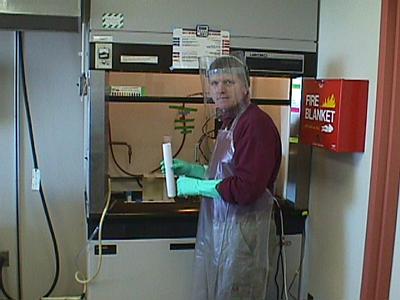
|
|
21 October, 1999
My job with the Cape Roberts Project (CRP) is to assist in the preparation
of samples that are taken from the drill cores as they are brought into the
lab. This job is a very small part of the project, but like all members of
the CRP team, each person needs to do his or her job in order for the
project to be successful. What I would like to do today is explain exactly
what I am doing in the lab and how my job fits into the scheme of the
project as a "hole". (It is a drilling project you know.)
So far the CRP drilling has been going very well. They have already
drilled about 250 meters into the sea floor at the bottom of the Ross Sea.
The drilling is proceeding at a rate of about 10 to 30 meters a day. The
rate varies due to the type of rock and sediments they are drilling through.
This means that the scientists have over 800 feet of core samples to analyze
already! Each day drill cores are flown by helicopter to McMurdo from the
drill site. I will be visiting the drill site at some later time and I will
tell you about what happens out there. Once the cores are brought to the
lab, each scientist selects which part of the core they wish to sample. This
is an important decision because there is not time nor resources to sample
every part of the core, but each scientist wants to learn as much as he or
she can from each core sample. A meeting is held each day before these
samples are selected and each member of the CRP science team comments on the
new core samples. They also tell everyone what they have learned so far from
previous samples. It is a real collaborative effort.
Once a scientist has selected a sample to be tested, he or she turns
it over to lab technicians who will process the sample for a specific
purpose. Each scientist wants to look at something different. Some want to
study the magnetic properties of the sample. Some want to study the larger
fossils (macrofossils) while others study the more numerous microfossils.
These include diatoms, foraminifera, and ostracods among others. The
scientists I am working with, John Wrenn, Rosemary Askin and Mike Hannah,
work on fossil spores, pollen and dinoflagellates. These types of fossils
require special processing to separate them from other, unwanted materials.
The first thing that is done is to log in and record the sample. It
is then ground up in a mortar and pestle. Part of the sample is then put in
a special microwave processor. During this process, the sample is subjected
to heat and, alternately, hydrochloric acid (HCl) and hydrofluoric acid
(HF). The HCL removes most of the fossils that are made up calcium carbonate
while the HF reacts with the fossils that are composed of silicates. Other
scientists study these in other samples. The heating of the microwave makes
the process go faster.
Then, the sample is rinsed, sieved and separated to remove the coarsest and
finest materials. The part of the sample which may contain the pollen,
spores, and dinoflaglelates (or palynomorphs) has a density greater then
water, and therefore will sink in water, but less then the heavier sand and
mineral parcticles. What is done now, is a lot like the density columns you
may have made in science class. A heavy liquid, with a density more that
twice that of water, is added. The lightest materials float to the top of
this heavy liquid, but remain below a layer of water. This "float" material
will contain the palynomorphs if they are present. This material is drawn
off and the palynologists study it under a microscope and try to identify
the different types of palynomorphs. This helps the scientists in the CRP
determine the age of the rock and the environment in which the fossils were
deposited.
I will discuss some of the results, so far, in a later journal.
Below are some pictures of my self and John Simes, head of the palynology
lab, processing some samples.
I will not be writing a journal tomorrow. I will be at a snowcraft
course, or "Happy Camper School", to learn how to survive is the Antarctic
environment. I'll be sleeping overnight! Next time I write, I will tell you
all about it.

Here I am in the palynology lab removing a sample from the microwave digester.

John Simes, a Kiwi from Wellington, working in the Crary Palynology lab.
Contact the TEA in the field at
.
If you cannot connect through your browser, copy the
TEA's e-mail address in the "To:" line of
your favorite e-mail package.
|
